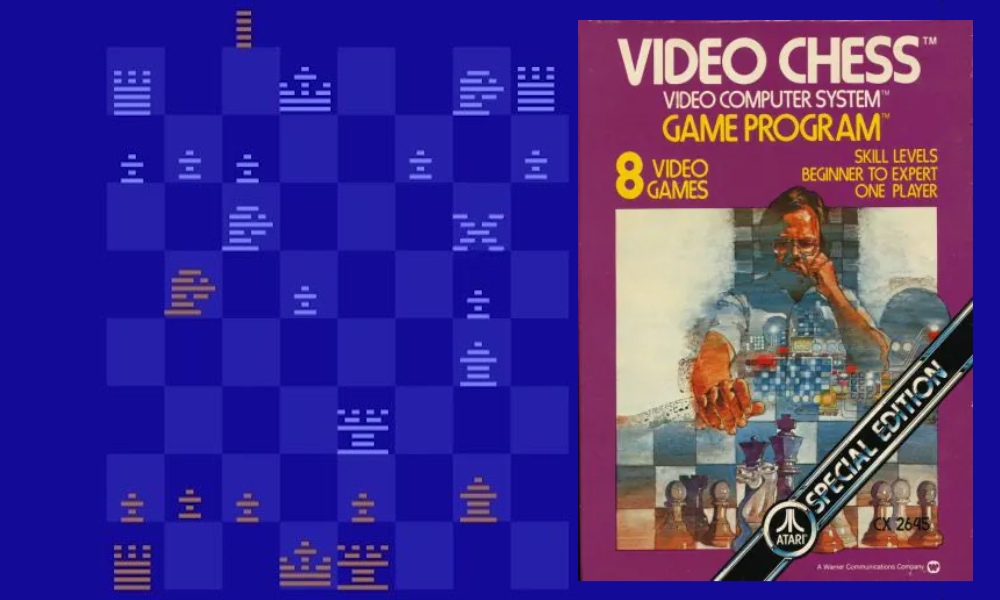Atari Video Chess Requires Only 4 KB to Easily Conquer ChatGPT and Microsoft’s Copilot
 Jesse Hollington / iDrop News
Jesse Hollington / iDrop News
Toggle Dark Mode
I’m an older individual, and I admit I get a secret feeling of satisfaction when I see a young whippersnapper get served their comeuppance by an old fart — even if that old fart is a nearly 50-year-old game cartridge for an ancient video game console. Atari Video Chess is that old fart!
We’ve all seen plenty of reports about how artificial intelligence platforms like OpenAI’s ChatGPT and Microsoft’s Copilot are threatening to defeat us by taking our jobs. However, I think chess champions will be able to hold their own for a bit longer against AI, since Atari Video Chess, a 4 KB video game cartridge made for one of the first video game consoles the Atari VCS/2600, has been able to kick both AIs in their virtual butts when it comes to playing chess!
Computer engineer Robert Caruso recently decided to pit ChatGPT against a virtual foe playing at a beginner level, which would only allow the opponent to plan a few moves ahead. He shared his experience in a LinkedIn post and said the results of the test prove ChatGPT isn’t exactly a chessmaster.
While Atari didn’t release the first video game console for the home — that honor goes to 1973’s Magnavox Odyssey — it’s still credited with making home video games a thing. In 1977, the then California-based company released the Atari VCS/2600 video game console. The console became quite popular, thanks to the release of home versions of Space Invaders, Asteroids, Missile Command, Pac-Man, and more. However, the company also catered to more, um, “cerebral” gamers with titles like Video Chess and Blackjack.
Video Chess used a computer program that had been squeezed into 4 KB of memory (yes, that’s four kilobytes, not 4 MB or 4 GB of memory) that provided the ability for a human player to challenge it in a game set to one of eight difficulty levels.

So, how well did ChatGPT fare against Video Chess? Let’s let Robert tell us:
ChatGPT got absolutely wrecked on the beginner level. This was after a conversation we had regarding the history of AI in Chess which led to it volunteering to play Atari Chess. It wanted to find out how quickly it could beat a game that only thinks 1-2 moves ahead on a 1.19 MHz CPU.
Apparently, ChatGPT confused rooks for bishops, missed pawn forks, and constantly lost track of where pieces were on the board. Like a truly bad chess player would, the AI first blamed the Atari icons for being too abstract to recognize, only to fare no better after switching to standard chess notation.
Meanwhile, Atari’s little 8-bit engine that could just kept chugging along, kicking ChatGPT’s virtual butt.
As for Microsoft’s Copilot, while it sat down at the board, it fared no better. Although Copilot “was brimming with confidence,” noted Caruso. The AI even promised to take it easy on Atari Video Chess, by only looking 3 to 5 moves ahead, instead of its usual 10 to 15 moves.
In the pre-game chat, Copilot suggested Caruso should “Keep an eye on any quirks in the Atari’s gameplay… it sometimes made bizarre moves!” Cocky bastard.
It took only seven turns before it was obvious that Atari Video Chess would be the victor.
Even though Caruso provided screenshots after every one of Atari’s moves, Copilot never delivered its promised “strong fight.”
By its seventh turn, Copilot had lost “two pawns, a knight, and a bishop — for only a single pawn in return.” It was also contemplating what is generally accepted to be chess suicide: giving away its queen.
The game came to a premature end when Caruso discovered the AI’s understanding of the positions of the pieces on the boards was less than realistic. While Copilot wanted to continue with the game, Caruso ended things.
It should be noted that Copilot was gracious in defeat, saying it had enjoyed the game and that, “Even in defeat, I’ve got to say: that was a blast… Long live 8-bit battles and noble resignations!”







